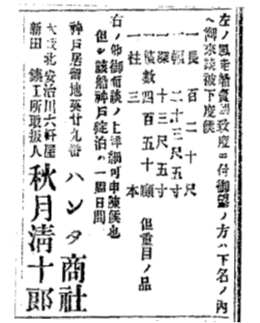3. E.H. Hunter & Co. at Kobe Foreign Settlement No. 29
A short distance from the bustle of the shoppers and tourists around Kobe's Motomachi Station unfolds a townscape with a leisurely Western ambience—the former Kobe Foreign Settlement. Constructed in 1868, when the port opened to trade, it was a special area where foreigners were allowed to live and work. Operation continued until 1899.

September 21, 1881
Having left E.C. Kirby & Co., E.H. Hunter set up E.H. Hunter & Co. and launched a trading business in October 1874, at the age of 32. His office at Kobe Foreign Settlement No. 29 was located at what is now the southwestern corner of the intersection between Harimamachi-suji and Nakamachi-dori streets in Harimamachi, Chuo-ku, Kobe.
The Hundred Year History says E.H. Hunter & Co. "listed Seijuro Akizuki as a partner and handled a range of products centering on construction machinery and materials, machine tools, and coatings." That is, the company made the first move, anticipating a trend in Western-style architecture not only in the foreign settlement but also throughout Japan.(1) The Seinan War of 1877(aka the Satsuma Rebellion) enabled E.H. Hunter & Co. to reinforce the foundation of its business.
By 1897, E.H. Hunter & Co. had expanded into an importer of ironware, machinery, foreign liquors, and medicines; exporter of antimony, manganese, copper, sulfur, and coal; construction and engineering contractor; sole agency for Nihon(or Nippon) Seimai K.K.(rice mill); and agency for Osaka Iron Works.(2) Around 1918, "Besides its main office in Harimamachi, Kobe, it had branch and liaison offices in Osaka, Tokyo, Kyoto, Yokosuka, Kure, Kokura, Taipei, Korea, Dalian, and as far away as London and New York . . . and engaged in vigorous business activities."(3)
Akizuki was a colleague of Hunter's at E.C. Kirby & Co., and together with Hunter and others, invested 10,000 yen each in the establishment of Osaka Iron Works. An advertisement in the Asahi Shimbun newspaper dated September 21, 1881(4) describes Akizuki as an "iron works agent." He was "stubborn . . . a man of his word . . . with the courage to see things through to the end."(5) By 1890 or so, "Osaka Iron Works General Manager Seijuro Akizuki . . . having suffered many hardships . . . has become one of the wealthiest merchants in the prefecture."(6) One can assume this is a result of his innate commitment.
The Nagasaki Foreign Settlement, established a decade or so earlier in the island of Kyushu, was the home of Glover & Co., a merchant that set up business in 1862 and played a key role around the Meiji Restoration of 1868. The proprietor, Thomas Blake Glover, later expanded into coal mine development and shipbuilding, but went bankrupt in 1870. This compares to Hunter, who also started as a trader and branched out into shipbuilding, as well as other new fields, and became a "successful entrepreneur based in Japan."(7) One imagines that Hunter's success is a product of sheer will power even stronger than that of Akizuki.
Bibliography
- 1『日立造船百年史』昭和60年、日立造船株式会社、6p
- 2田井玲子『外国人居留地と神戸』2013年、神戸新聞総合出版センター、202p
- 3五十嵐栄吉編『大正人名辞典下巻』1987年、底本『大正人名辞典』第四版 大正7年 東洋新報社、日本図書センター
なお、この時期にはハンター商会は「合名会社範多商会」となっている。 - 4『川口居留地3』川口居留地研究会1994年64p
- 5米倉萩露著『当世人物管見』明治26年、米倉領次郎発行、1p
- 6吉弘白眼著『当世名士譚』第一巻明治25年、米倉領次郎発行、98p
- 7杉山伸也 『日英経済関係史研究1860~1940』2017年、慶応義塾大学出版会株式会社、28p
- Photo4
Asahi Shimbun 1881.09.21 Page4 Advertisement
Click here for various inquiries
- 1. Maizuru Maru
- 2. Hunter and Aiko
- 3. E.H. Hunter & Co. at Kobe Foreign Settlement No. 29
- 4. Rokko Maru: Wooden steamship on the "golden route"
- 5. E. H. Hunter, a man with Japanese spirit and Western technology(part 1)
- 6. Japanese spirit, Western technology (part 2)
- 7. Bronze statue of E.H. Hunter (part 1)
- 8. Bronze statue of E.H. Hunter (part 2)
- 9. Temple bell tuned to 122 cycles with Shosoin flute